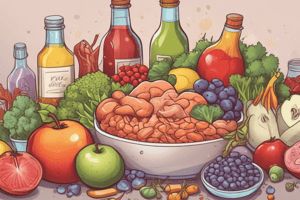Podcast
Questions and Answers
What are the major classes of dietary lipids?
What are the major classes of dietary lipids?
- Triglycerides
- Sterols
- Phospholipids
- All of the above (correct)
Fatty acids are classified by which factors?
Fatty acids are classified by which factors?
Length of the chain, whether the carbons have a single or a double bond, and the total number of double bonds.
The 'backbone' of a triglyceride is a __________ molecule.
The 'backbone' of a triglyceride is a __________ molecule.
glycerol
Bile is made in the __________ and stored in the __________.
Bile is made in the __________ and stored in the __________.
Where does the majority of fat digestion occur?
Where does the majority of fat digestion occur?
Which lipoprotein has the highest percentage of cholesterol?
Which lipoprotein has the highest percentage of cholesterol?
What does LDL do in the body?
What does LDL do in the body?
Very-low-density lipoproteins (VLDLs) are composed mostly of?
Very-low-density lipoproteins (VLDLs) are composed mostly of?
How many calories are provided by 20 grams of fat?
How many calories are provided by 20 grams of fat?
Which foods are the richest sources of omega-3 fatty acids?
Which foods are the richest sources of omega-3 fatty acids?
Which food item contains the most dietary cholesterol per serving?
Which food item contains the most dietary cholesterol per serving?
Dietary cholesterol is found in foods from?
Dietary cholesterol is found in foods from?
What are good sources of monounsaturated fatty acids?
What are good sources of monounsaturated fatty acids?
Saturated fats are most likely to be found in __________.
Saturated fats are most likely to be found in __________.
The majority of trans fats in foods are created by food manufacturers through the process of __________.
The majority of trans fats in foods are created by food manufacturers through the process of __________.
What are current dietary fat recommendations for good health?
What are current dietary fat recommendations for good health?
Which form of lipoprotein in the blood is the healthiest?
Which form of lipoprotein in the blood is the healthiest?
During the digestive process, most lipids are absorbed into?
During the digestive process, most lipids are absorbed into?
The abundant lipid in your body is __________.
The abundant lipid in your body is __________.
Most chemical digestion of fat occurs in the __________.
Most chemical digestion of fat occurs in the __________.
The lipoprotein that removes cholesterol from the tissues and delivers it to the liver to be used is __________.
The lipoprotein that removes cholesterol from the tissues and delivers it to the liver to be used is __________.
Which foods provide the best sources of heart-healthy omega-3 fatty acids?
Which foods provide the best sources of heart-healthy omega-3 fatty acids?
The Acceptable Macronutrient Distribution Range (AMDR) for dietary fat is between __________.
The Acceptable Macronutrient Distribution Range (AMDR) for dietary fat is between __________.
Which dietary component raises low-density lipoprotein (LDL) cholesterol the most?
Which dietary component raises low-density lipoprotein (LDL) cholesterol the most?
What are good sources of the essential fatty acids linoleic acid and alpha-linolenic acid?
What are good sources of the essential fatty acids linoleic acid and alpha-linolenic acid?
To raise your level of high-density lipoprotein (HDL) cholesterol, you can?
To raise your level of high-density lipoprotein (HDL) cholesterol, you can?
Trans fats are unhealthy for your heart because they?
Trans fats are unhealthy for your heart because they?
What does VLDL do?
What does VLDL do?
What are eicosanoids?
What are eicosanoids?
Consume less than ___ mg of cholesterol a day.
Consume less than ___ mg of cholesterol a day.
What is atherosclerosis?
What is atherosclerosis?
What are the two essential fatty acids?
What are the two essential fatty acids?
Flashcards
Dietary Lipids
Dietary Lipids
Triglycerides, sterols, and phospholipids are major types of these macronutrients in our diet.
Fatty Acid Classification
Fatty Acid Classification
Characterized by chain length, presence of double bonds, and the number of double bonds.
Triglyceride Structure
Triglyceride Structure
Composed of a glycerol molecule serving as the backbone with three fatty acids attached.
Bile
Bile
Signup and view all the flashcards
Fat Digestion Location
Fat Digestion Location
Signup and view all the flashcards
LDL
LDL
Signup and view all the flashcards
VLDL
VLDL
Signup and view all the flashcards
Fat Caloric Content
Fat Caloric Content
Signup and view all the flashcards
Omega-3 Fatty Acid Sources
Omega-3 Fatty Acid Sources
Signup and view all the flashcards
Sources of Dietary Cholesterol
Sources of Dietary Cholesterol
Signup and view all the flashcards
Sources of Monounsaturated Fats
Sources of Monounsaturated Fats
Signup and view all the flashcards
Saturated Fats Sources
Saturated Fats Sources
Signup and view all the flashcards
Trans Fats Production
Trans Fats Production
Signup and view all the flashcards
Daily Cholesterol Limit
Daily Cholesterol Limit
Signup and view all the flashcards
Recommended Fat Intake
Recommended Fat Intake
Signup and view all the flashcards
HDL
HDL
Signup and view all the flashcards
Lipid Absorption System
Lipid Absorption System
Signup and view all the flashcards
Predominant Lipid
Predominant Lipid
Signup and view all the flashcards
HDL Function
HDL Function
Signup and view all the flashcards
AMDR for Fat
AMDR for Fat
Signup and view all the flashcards
Fats Elevating LDL
Fats Elevating LDL
Signup and view all the flashcards
Essential Fatty Acids
Essential Fatty Acids
Signup and view all the flashcards
Ways to Increase HDL
Ways to Increase HDL
Signup and view all the flashcards
Risks of Trans Fats
Risks of Trans Fats
Signup and view all the flashcards
VLDL Function
VLDL Function
Signup and view all the flashcards
Eicosanoids
Eicosanoids
Signup and view all the flashcards
Atherosclerosis
Atherosclerosis
Signup and view all the flashcards
Study Notes
Major Classes of Dietary Lipids
- Types of dietary lipids: triglycerides, sterols, phospholipids.
Fatty Acid Classification
- Classified by chain length, presence of double bonds, and total number of double bonds.
Triglyceride Structure
- Backbone of triglycerides is a glycerol molecule.
Bile Production and Storage
- Bile is produced in the liver and stored in the gallbladder.
Digestion of Fats
- Majority of fat digestion occurs in the small intestine.
Lipoproteins and Cholesterol
- Low-density lipoprotein (LDL) has the highest percentage of cholesterol.
- LDL deposits cholesterol in artery walls, potentially leading to heart disease.
- Very-low-density lipoproteins (VLDLs) are primarily composed of triglycerides.
Caloric Content of Fat
- 20 grams of fat provides 180 calories (1 gram fat = 9 calories).
Sources of Omega-3 Fatty Acids
- Richest sources are salmon and other cold-water fish.
Dietary Cholesterol Sources
- Whole milk contains the highest dietary cholesterol per serving.
- Dietary cholesterol is found in animal products.
Monounsaturated Fatty Acids
- Good sources include nuts, cashews, almonds, olives, olive oil, and canola oil.
Saturated Fats
- Commonly found in animal products like meat and dairy.
Trans Fats Production
- Majority are created through hydrogenation.
Dietary Fat Recommendations
- Cholesterol intake should be less than 300 mg/day.
- Fat intake should be 20-35% of total calories.
- Minimize trans fat and limit saturated fat to no more than 10% of total fat intake.
Healthy Lipoproteins
- High-density lipoprotein (HDL) is the healthiest form of lipoprotein.
Lipid Absorption
- Most lipids are absorbed into the lymphatic system during digestion.
Predominant Lipid in the Body
- Triglycerides are the most abundant lipid.
Chemical Digestion of Fat
- Predominantly occurs in the small intestine.
HDL Function
- HDL removes cholesterol from tissues and transports it to the liver.
Heart-Healthy Omega-3 Sources
- Shrimp and salmon are excellent sources of omega-3 fatty acids.
Acceptable Macronutrient Distribution Range (AMDR)
- Dietary fat should constitute 20-35% of daily calories.
LDL Cholesterol Elevation
- Saturated fats raise low-density lipoprotein (LDL) cholesterol levels the most.
Essential Fatty Acids
- Linoleic acid and alpha-linolenic acid are the essential fatty acids found in flaxseeds, walnuts, and soybean oil.
Increasing HDL Levels
- Engage in regular exercise and maintain a healthy weight to raise HDL cholesterol.
Risks of Trans Fats
- Trans fats increase LDL cholesterol and lower HDL cholesterol, posing heart health risks.
VLDL Function
- VLDL delivers fat synthesized in the liver to tissues.
Eicosanoids
- Hormone-like substances derived from essential fatty acids involved in inflammation, blood clotting, and blood pressure regulation.
Cholesterol Intake Guidelines
- Recommended to consume less than 300 mg of cholesterol daily.
Atherosclerosis
- Condition characterized by the buildup of plaque in arterial walls.
Studying That Suits You
Use AI to generate personalized quizzes and flashcards to suit your learning preferences.




